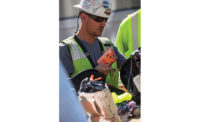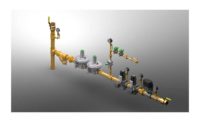 There have been countless articles and guides that outline all the key components to a successful lockout/tagout program. However, it goes beyond just purchasing padlocks, tags, and lockout devices. Even with a solid written plan, the ultimate success depends on your employees properly applying the lockout hardware according to your established procedures.
There have been countless articles and guides that outline all the key components to a successful lockout/tagout program. However, it goes beyond just purchasing padlocks, tags, and lockout devices. Even with a solid written plan, the ultimate success depends on your employees properly applying the lockout hardware according to your established procedures.
Even though lockout standards, such as OSHA 29 CFR 1910.147 (The Control of Hazardous Energy for General Industry), OSHA 29 CFR 1915.89 (Lockout/Tags-Plus for the Maritime Industry), and OSHA 29 CFR 1926.417 (Lockout and Tagging of Circuits for the Construction Industry), have been in effect for more than 20 years, this remains the third-most-frequent citation in general industry and the fifth-most-cited overall OSHA violation. With this in mind, it is critical to ensure your employees are informed of the latest technologies, standards, and training requirements in order to reduce citation costs, improve productivity, and eliminate injuries.
Keeping Employees Safe, Citations Down
With the increasing growth in technological development, new and more efficient machinery is being built to better service facilities and increase machine productivity. However, with the rise of modern machinery comes the rise of many hazards to workers, including hot fluids, moving presses, blades, propellers, electrical heaters, pinch points, moving chains, and more. Continuously training employees on new equipment procedures reduces the risk of hazards occurring and reestablishes your employees' proficiency in methods and procedures.
Not only does training help prevent injury; it saves you on costly regulations citations. According to OSHA, training of employees needs to happen annually at the very minimum. Employees should also be retrained any time there is a change in energy control procedures for equipment or if new equipment is installed. Often, the most near misses and accidents arise from an employee's being unaware or lacking the understanding of the change in hazardous energy to a piece of equipment.
For example, say you add an additional water line to a chiller. Your maintenance employee has been servicing this same chiller for years knowing there is only one water input. Your employee does not realize the second input has been added; therefore, he does not lock it out during his service, which in turn could result in an accident, increased insurance costs, lost work time, and high operating costs.
Adapting to New Technologies, Demographics
In an effort to prevent accidents and injuries and decrease costs, many new pieces of equipment are being manufactured with built-in lockout features. Whether it's a ball valve with a built-in sliding lock feature or a disconnect switch with a padlock hole attachment, there are many new ways to lock out a piece of equipment. Your company policy should clearly state which products are acceptable for locking out certain types of equipment and whether employees should use the built-in feature or apply your visual lockout devices.
Employees also need to be aware of the different varieties and styles of lockout devices, as well as the correct steps to use them. A plethora of lockout devices is available, and certain devices are more effective for specific types of equipment. This information and knowledge should be communicated to employees during your lockout training sessions.
An additional yet essential source of undocumented knowledge comes directly from within your facility — your long-term employees. Over the next few years, the demographics of your workforce will be changing dramatically. The baby boomer generation is nearing retirement, which means you may face a staggering knowledge loss. The incoming young employees, even though qualified, will lack the experience of using lockout/tagout devices, understanding of the proper steps and procedures that are required during shift changeovers, and w hat types of products supplement certain equipment. It is critical to your organization's success to mine the know ledge of your seasoned workers. Utilize their knowledge and embed it in your workplace environment as a form of training for newer employees.
The change in employee demographics also serves as an opportune time to truly enhance the visuals throughout your facility to make procedures clearer and readily available for each machine. The addition of a visual lockout procedure program can reduce error and make the steps within a process easier to understand.
Providing a 'Road Map' to Success
Let's say you need to drive to a specific location but you're not sure how to get there. There are a few different ways you could get direction information. You could stop and ask someone for directions; however, this often leads to inaccuracies. You could use a map, but the map could have out-of-date information, and you'd have to spread it over your steering wheel, which could lead to safety risks and misguided turns. Finally, you could use an electronic device and enter your destination. With the device's turn-by-turn instructions, likely you would have found the most efficient way of getting to your destination.
This same logic can also be applied to developing your lockout/tagout processes and procedures within your plant. There are three options to help you determine "how to get to your specific location":
1. Basic text documents (usually left in a binder in the safety or maintenance office, which often entails finding someone to ask questions or even requesting access to the binder).
2. CAD-style drawings show a "representation" of the equipment but still require employees to determine exactly where things are and how to accomplish the task.
3. Photograph-based, step-by-step (turn-by-turn) instructions that match what the worker is seeing in real time (the most effective and efficient option).
Providing all employees, especially newer ones, with the knowledge that seasoned employees have gained and supplementing it with visuals will enhance and improve your lockout/tagout training and workforce. However, it doesn't just stop there. There are a variety of training and communication tools available to continue training and informing your employees. Many companies offer online training services that are accessible directly from a work site computer, 24/7. These training tools usually include videos, demonstrations, quizzes, and more. You can also keep your facility up to date with visuals, including safety posters, a lockout/tagout procedure station, and signs to depict warnings, barricades, and other important messaging.
If you really want to enhance your safety program and expand the knowledge of your employees, utilize a third-party service to help your facility. There are companies that offer on-site lockout/tagout seminars or facility audits to determine how to improve your current program. Implementing a thorough lockout training program for your facility and employees will not only keep you OSHA compliant, but it will help to prevent injuries and accidents, in addition to enhancing the know ledge of your staff and creating a safer workplace.
About The Author
Danielle Gallo is a product marketing specialist for Brady Worldwide Inc.'s safety and facility identification products, including lockout/tagout devices, training materials, and other compliance products. She is actively involved in developing solutions for industry regulatory compliance and safety concerns.
Want to learn more about lockout/tagout procedures and devices?Brady has an extensive lockout/tagout solution including devices, tags, software and training to assist you in implementing a comprehensive lockout program. Call us at (65) 64777 7261 or email us at ContactUS_SA@bradycorp.com for more information.


